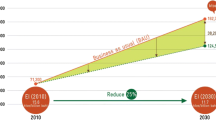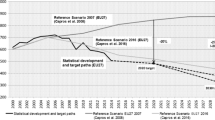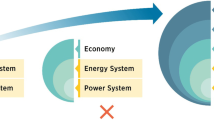Abstract
Access to abundant and affordable primary energy resources has been recognised as an essential factor for the prosperity of human societies. To measure their quality, understood as the ease with which the energy system can extract and transform them into a form useful to society, the concept of energy return on investment (EROI) is widely used. Yet, so far, very few estimates of this indicator exist at a society level. This paper first aims at providing an estimate of the societal EROI using a simple macroeconomic model with two sectors, an energy sector and a final sector aggregating the rest of the economy. For the year 2018 and at a worldwide level, we obtain a gross EROI of 9.4, and a net EROI of 8.5. The estimation of the net energy ratio (NER), a second indicator more comprehensive than the EROI, allows assessing the energy embodied in the intermediate and capital consumptions of the entire economy. The NER calculation reveals that only 39% of the final energy produced contributes to total consumption (private and public) and economic growth, the remaining 61% being consumed within the economy. These intermediate energy consumptions (direct and indirect) are unevenly distributed between the two sectors: 11% of the production goes to the energy sector, while no less than 50% is consumed within the final sector. These figures proved to be very insensitive to variations in the value of estimated model parameters.

Similar content being viewed by others
Notes
However, according to the authors, these improvements will certainly be limited, given that the transition to renewable energies corresponds to an abrupt shift to a capital intensive energy system. The most significant part of the energy inputs to a fully renewable energy system are linked to raw materials extraction and processing. It will be difficult to reduce the energy needs for the industrial processes needing really high temperatures, and the impacts of metal depletion on the cost of extraction of those materials will have a negative impact on the energy inputs (as highlighted for example by Fizaine and Court (2015)).
The relationship is, however, non-linear (in the sense that the HDI increases less and less rapidly with societal EROI) and is characterized by a saturation effect.
This concept, which measures the share of the total energy produced that is available for final demand, is to be differentiated from the NER as defined by Brandt and Dale (2011), which is a variant of the EROI which measures the ratio between the net energy produced and the energy invested.
This estimate of the embodied energy is based on the energy content of the share of the investment (at time t) used to replace the capital that has become obsolete (at time t). An alternative approach would have been to estimate the embodied energy in the capital stock based on the energy content of past investments. Since \(q_{\text{f}}\) decreases over time, this approach would lead to a higher estimate of the embodied energy contained in the flow measuring capital depreciation.
For example, for global power generation, Kis et al. (2018) obtain an estimate of 7.4 for GER and 11.3 for GEER.
See Ribeiro et al. (2007) for the breakdown by mode of transport of the energy dedicated to transport at the global level.
References
Ayres RU, van den Bergh JCJM, Lindenberger D, Warr B (2013) The underestimated contribution of energy to economic growth. Struct Change Econ Dyn 27:79–88. https://doi.org/10.1016/j.strueco.2013.07.004
Brand-Correa L, Brockway PE, Copeland CL, Foxon TJ, Owen A, Taylor PG (2017) Developing an input–output based method to estimate a national-level energy return on. Energies 10(534):1–21. https://doi.org/10.3390/en10040534
Brandt AR (2017) How does energy resource depletion affect prosperity? Mathematics of a minimum energy return on investment (EROI). Biophys Econ Resour Q 2(1):1–12. https://doi.org/10.1007/s41247-017-0019-y
Brandt AR, Dale M (2011) A general mathematical framework for calculating systems-scale efficiency of energy extraction and conversion: energy return on investment (EROI) and other energy return ratios. Energies 4:1211–1245. https://doi.org/10.3390/en4081211
Brockway PE, Owen A, Brand-correa L, Hardt L (2019) Estimation of global final stage energy-return-on-investment for fossil fuels with comparison to renewable energy sources. Nat Energy 4(7):612–621
Capellán-Pérez I, de Castro C, Javier L, González M (2019) Dynamic energy return on energy investment (EROI) and material requirements in scenarios of global transition to renewable energies energy return on energy invested energy stored on energy invested. Energy Strateg Rev 26(July):100399. https://doi.org/10.1016/j.esr.2019.100399
Capellán-Pérez I, de Blas I, Nieto J, de Castro C, Miguel LJ, Carpintero O, Mediavilla M, Lobejon LF, Ferreras-alonso N, Rodrigo P, Frechoso F, Alvarez-Antelo D (2020) MEDEAS: a new modeling framework integrating global biophysical and socioeconomic constraints. Energy Environ Sci 10:20. https://doi.org/10.1039/C9EE02627D
Court V (2019) An estimation of different minimum exergy return ratios required for society. Biophys Econ Resour Q 4(3):1–13. https://doi.org/10.1007/s41247-019-0059-6
Court V, Fizaine F (2016) Energy expenditure, economic growth, and the minimum EROI of society. Energy Policy 95(June 2018):172–186. https://doi.org/10.1016/j.enpol.2016.04.039
Dale M, Krumdieck S, Bodger P (2012) Global energy modelling: a biophysical approach (GEMBA) part 2: methodology. Ecol Econ 73:158–167. https://doi.org/10.1016/j.ecolecon.2011.10.028
Dale MC (2019) When is EROI not EROI ? Biophys Econ Resour Q 4(16):1–4. https://doi.org/10.1007/s41247-019-0065-8
European Central Bank (2006) Estimates of the Euro Area capital stock. ECB Mon Bull (May) 45–47
Fagnart J-F, Germain M (2016) Net energy ratio, EROEI and the macroeconomy. Struct Chang Econ Dyn 37:121–126. https://doi.org/10.1016/j.strueco.2016.01.003
Fizaine F, Court V (2015) Renewable electricity producing technologies and metal depletion: a sensitivity analysis using the EROI. Ecol Econ 110:106–118. https://doi.org/10.1016/j.ecolecon.2014.12.001
FRED. Intermediate inputs dynamics (2018) https://fredblog.stlouisfed.org/2018/06/intermediate-input-dynamics/
Gagnon N, Hall CAS, Brinker L (2009) A preliminary investigation of energy return on energy investment for global oil and gas production (September) https://doi.org/10.3390/en20300490
Hall CAS, Balogh S, Murphy DJR (2009) What is the minimum EROI that a sustainable society must have? Energies. https://doi.org/10.3390/en20100025
King CW, Maxwell JP, Donovan A (2015) Comparing world economic and net energy metrics, part 2: total economy expenditure perspective. Energies 8:12975–12996. https://doi.org/10.3390/en81112347
Kis Z, Pandya N, Koppelaar RH (2018) Electricity generation technologies: comparison of materials use, energy return on investment, jobs creation and CO2emissions reduction. Energy Policy 120:144–157. https://doi.org/10.1016/j.enpol.2018.05.033
Kümmel R, Lindenberger D, Weiser F (2015) The economic power of energy and the need to integrate it with energy policy. Energy Policy 86:833–843. https://doi.org/10.1016/j.enpol.2015.07.026
Lambert JG, Hall CAS, Balogh S, Gupta A, Arnold M (2014) Energy, EROI and quality of life. Energy Policy 64:153–167. https://doi.org/10.1016/j.enpol.2013.07.001
Murphy DJ, Hall CAS, Dale M, Cleveland C (2011) Order from chaos: a preliminary protocol for determining the EROI of fuels. Sustainability. https://doi.org/10.3390/su3101888
Murphy DJ, Dale M, Moeller D (2016) Comparing apples to apples: why the net energy analysis community needs to adopt the life-cycle analysis framework. Energies 9:917. https://doi.org/10.3390/en9110917
OECD. Input-Output Tables (2015) http://oe.cd/i-o
Raugei M (2019a) Net energy analysis must not compare apples and oranges. Nat Energy 4:86–88
Raugei M (2019b) Energy return on investment: setting the record straight. Joule 3(8):1810–1811. https://doi.org/10.1016/j.joule.2019.07.020
Ribeiro K, Kobayashi S, Beuthe M, Gasca J, Greene D, Lee DS, Muromachi Y, Newton PJ, Plotkin S, Sperling D, Wit R, Zhou PJ, Davidson OR, Bosch PR, Dave R, Kingdom U (2007) Transport and its infrastructure. In: Metz B, Davidson OR, Bosch PR, Dave R, Meyer LA (eds) Climate change 2007 mitigation contribution work grade III to fourth assess report intergovernmental panel on climate change. Cambridge University Press, Cambridge
Statistics Canada (2007) Depreciation rates for the productivity accounts. Can Product Rev
Author information
Authors and Affiliations
Corresponding author
Additional information
Publisher's Note
Springer Nature remains neutral with regard to jurisdictional claims in published maps and institutional affiliations.
Appendix 1
Appendix 1
Development of (17)
Unlike in Fagnart and Germain (2016), there are in the present model deliveries of the ES to private and public consumption (\(C_{\text{e}}\ne 0\)). In the following, we develop a relationship between the useful ouput of the economy and the energy production \(Y_{\text{e}}\). The first approach is based on the definition of final consumption and establishes its relationship with \(Y_{\text{e}}\), while the second approach consists in directly calculating the fraction of \(Y_{\text{e}}\) contained in the ICCs of both sectors.
Link between final consumption and \(Y_{\text{e}}\)
(1), (4), (5), (6), (7) lead to the following equations linking sectoral outputs \(Y_i\) and final consumptions \(C_i\) (\(i=e,f\)):
We define \(D_{\text{f}}\) as the final demand (sum of consumption of final goods and net investment), and isolate both \(C_{\text{e}}\) and \(D_{\text{f}}\) to find:
The first equation gives an expression for \(Y_{\text{f}}\) that we incorporate in the second equation to write the following relationship between \(Y_{\text{e}}\), \(C_{\text{e}}\) and \(D_{\text{f}}\):
Let \(\zeta =C_{\text{e}}/Y_{\text{e}}\) be the fraction of energy production sold for final consumption. Then the previous equation becomes:
This equation gives the quantity of goods that can be delivered to final demand (sum of consumption and net investment) from a certain amount of final energy. The theoretical maximal output is given by the ratio \(\frac{Y_{\text{e}}}{q_{\text{f}}}\). The fraction that actually reaches the FS is given by \((1-q_{\text{e}}-\zeta )\), it corresponds to the energy flow \(E_{\text{f}}\). Then the first loss is the fraction of \(Y_{\text{e}}\) consumed by the NEIC and capital consumption (CC) of the ES, measured by \(q_{\text{f}} w_{\text{e}}\), and the second loss is the fraction of \(Y_{\text{e}}\) consumed by the NEIC and CC of the FS, measured by \((1-q_{\text{e}}-\zeta ) w_{\text{f}}\). These losses can be further distributed between \(C_{\text{e}}\) and the rest of the ouput \(Y_{\text{e}}\) (see Sect. 2.4).
Link between the NEICs and CCs of both sectors and \(Y_{\text{e}}\)
We indeed find the last terms of (30).
Given the definition of the net domestic product (16), Eq. (30) gives an expression for the NDP as a function of the technical parameters, the fraction \(\zeta\), and the production \(Y_{\text{e}}\):
which corresponds to equation (17).
Link Between v, g and \(g_k\)
Using (4), (11) and (3) we write:
Hence the capital growth rate \(g_k\) is given by:
Be g the GDP growth rate: \(g = \frac{\Delta \text{GDP}}{\text{GDP}}\). Starting from (3), one can write at first order \(g_{v}=\frac{\Delta v}{v} = \frac{\Delta K}{K} - \frac{\Delta \text{GDP}}{\text{GDP}}\), which implies Eq. (26):
GDP growth is decomposed into the growth of the capital stock and the decline in the capital intensity of the economy.
Validation of \(g_v=0\)
In the reference calibration, the capital intensity of the economy (v=\(\frac{K}{\text{GDP}}\)) was assumed to be constant, and therefore \(g_v\) was zero. This assumption can be validated as follows. One can do the exercise of estimating v for the years 1990 to 2018 via the previous equations. A posteriori, we observe that this parameter is more or less constant, regardless of the hypothesis that we postulated a priori for its rate of variation \(g_v\). From then on, the starting postulate \(g_v = 0\) is the only valid one.
Rights and permissions
About this article
Cite this article
Dupont, E., Germain, M. & Jeanmart, H. Estimate of the Societal Energy Return on Investment (EROI). Biophys Econ Sust 6, 2 (2021). https://doi.org/10.1007/s41247-021-00084-9
Received:
Revised:
Accepted:
Published:
DOI: https://doi.org/10.1007/s41247-021-00084-9




